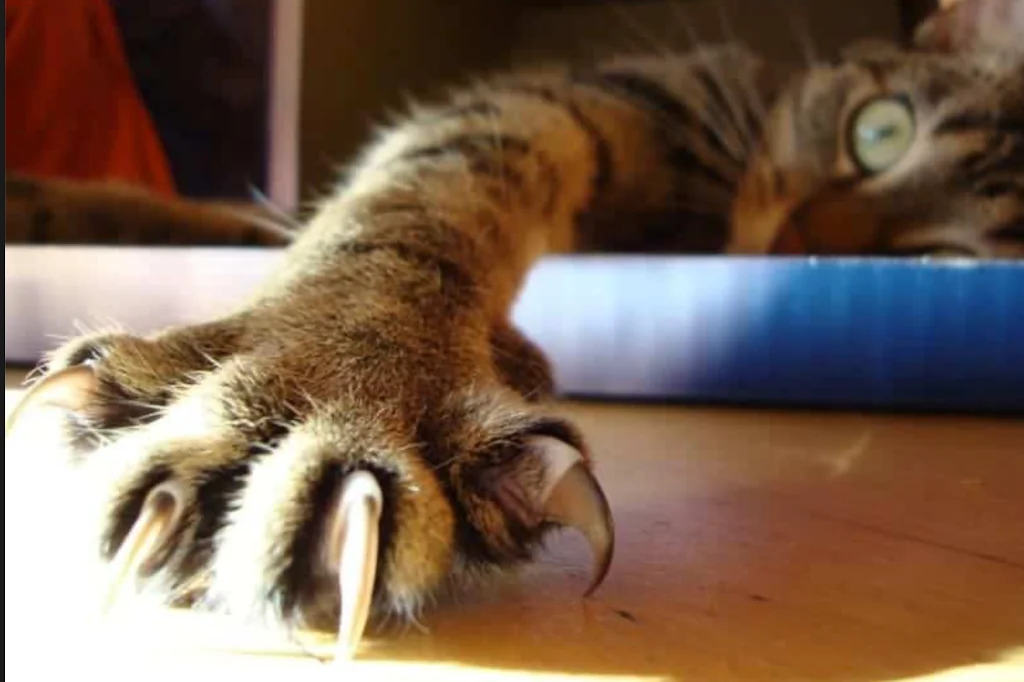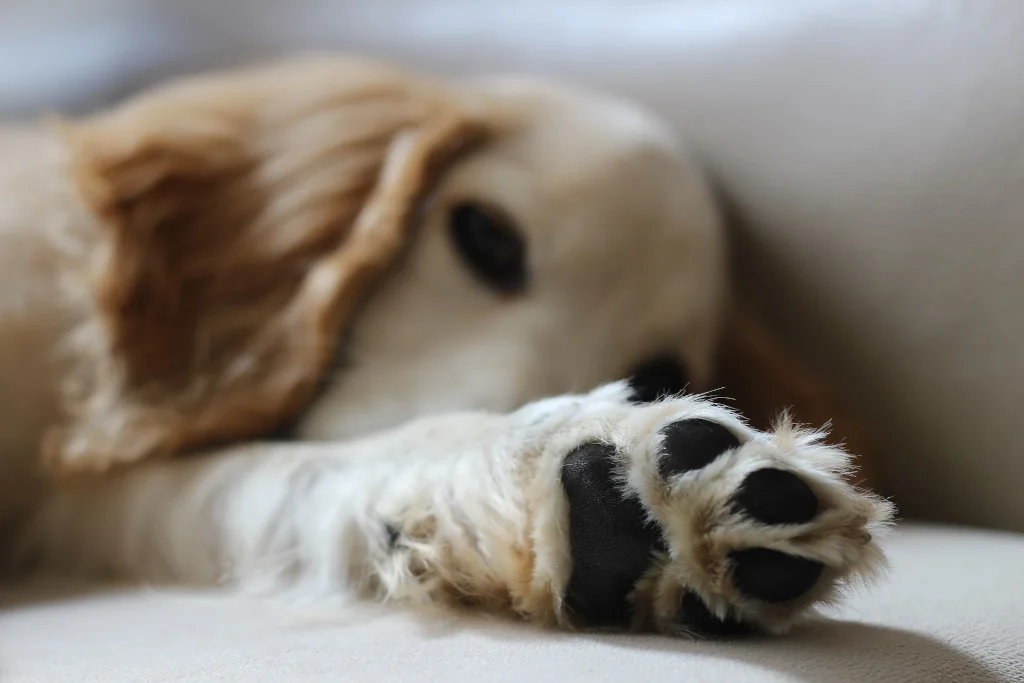Disclosure: We may earn a commission from helpful, relevant links in our content. No cost to you. See our privacy policy.
Ever wondered why your furry friends have such distinctive paws? You’re not alone. Many pet owners are perplexed by the unique adaptations in their pets’ paws.
Understanding these remarkable differences can transform how you interact with and care for your beloved pets. Let’s see what’s so special about dog and cat paws in more detail.

What Special Features Dogs Have in Their Paws?
Dogs, known for their resilience and endurance, have paws that are designed just for that!
A dog’s paw is essentially a shock absorber. It contains fatty tissue that cushions impact, protecting bones and joints during running and jumping.
Plus, have you noticed those small bumps on the bottom of your dog’s paws? They’re called paw pads, which provide extra grip and resist extreme temperatures. Not to mention, some breeds even have webbed feet, a unique adaptation that aids in swimming.
Every feature serves a distinct purpose, contributing to dogs’ versatile abilities.
How are Cat Paws Adapted Differently than Dogs?
Cats are the perfect embodiment of agility and stealth, and their paws play a significant role in this.
Unlike dogs, cats have retractable claws that stay sharp for precise catching and climbing. While they may get stuck on things occasionally, they are quite effective most of the time.
Their soft, squishy paw pads allow for silent stalking, crucial for a natural-born hunter. Moreover, cat paws are incredibly sensitive to touch, detecting the slightest vibrations in their surroundings – a superpower-like trait that aids them in hunting.
Understanding the unique adaptations of cat paws gives us an incredible insight into their secretive world.
Why are Cat Paws Perfect for Hunting?

Cat paws are a marvel of nature, specifically evolved to turn these elegant creatures into effective hunters.
A key characteristic of their hunting prowess lies in the retractable claws. These sharp tools stay protected when not in use, maintaining their razor-sharp edge for when it’s time to strike.
Moreover, the soft paw pads mute their steps, making cats nearly silent stalkers. The pad’s sensitivity enables cats to pick up minute vibrations, informing them of nearby prey or potential danger.
Plus, their flexible joints allow them to swivel their paws, offering them a greater range of motion to grab and hold onto their prey. Thus, every detail of a cat’s paw works in harmony, making them the perfect hunting machines they are.
Do Dogs and Cats Use Their Paws Differently?
Yes, dogs and cats use their paws in remarkably different ways, reflecting their unique evolutionary paths.
Dogs primarily use their sturdy paws for locomotion and digging. With excellent endurance, a dog’s paw is built for long-distance running, chasing, and playful romping. The protective paw pads offer them a good grip on various terrains, while the fatty tissue absorbs shock, safeguarding their joints and bones.
In contrast, a cat’s paw is a multi-functional tool. Besides locomotion, the paws are critical for hunting, climbing, and self-defense. The retractable claws allow them to catch prey, climb trees, and fend off threats effectively. The heightened sensitivity in cat paws also helps them sense their environment, alerting them to any potential dangers or opportunities.
In essence, while both species use their paws as tools, the ways in which they use them are distinct, showcasing the amazing adaptability of nature.
Did You Know?
Cats use their paws in some surprisingly human ways. For instance, they have been observed using their paws to scoop water, just like we might use our hands. Additionally, cats often use their paws to investigate new objects, touching and tapping curiously, much like a human toddler might. So next time you see your feline friend batting a toy mouse around, remember – it’s not just play, it’s a display of their incredible paw dexterity!
Here’s a quick comparison table of dog and cat paws:
| Dog Paws | Cat Paws | |
| Claws | Extended for traction | Retractable for sharpness |
| Usage | Locomotion, digging | Locomotion, hunting |
| Special Features | Shock-absorbing, good grip | Soft, silent, sensitive |

Interesting Facts About Dog and Cat Paws
Dog and cat paws are full of fascinating facts that showcase the intricate design of nature. Here are some noteworthy ones:
- Paw prints tell a story. If you’ve ever studied a dog’s paw print, you’ll notice that it’s symmetrical with a distinct pattern of pads. Cats, however, leave a more asymmetric footprint, and interestingly, it’s hard to spot their claw marks since they’re retractable and only come out when needed.
- Sweat glands? Yes, in their paws. Both dogs and cats sweat through their paw pads. This not only helps in thermoregulation, but for dogs, the scent released aids in marking territory. Cats, on the other hand, have additional scent glands on their paws that they use for the same purpose.
- Unique ‘fingerprints’. Just like human fingerprints, the ridges on a dog’s nose are unique to each individual. But did you know this uniqueness extends to their paw pads too? That’s right, dogs have unique paw prints!
- Touchscreen-friendly paws. Here’s a fun fact: Dogs and cats can use touchscreens! Their paw pads can mimic the heat and pressure of a human finger, allowing them to interact with your tablet or smartphone.
- Natural shock absorbers. The fat inside the paw pads of both dogs and cats acts as natural shock absorbers, cushioning their steps, and reducing impact on their joints, especially during high-speed chases or long jumps.
Tips for Paw Care
As a pet owner, it’s important that you pay attention to the health of your pet’s paws. Here are a few tips:
- Regular Checks. Always check your pet’s paws after they’ve been outside. Look out for any foreign objects, cuts, or abrasions.
- Nail Trimming. Ensure your pet’s nails are trimmed regularly. Overgrown nails can be uncomfortable and even painful. For cats, the JW GripSoft Nail Clippers are a safe and easy-to-use option. For dogs, you may want to try the BOSHEL Dog Nail Clippers, which comes with a safety guard to prevent over-cutting.
- Moisturize. Just like human skin, your pet’s paw pads can crack and dry out. Using a balm like Natural Dog Company Paw Soother, can help protect your dog’s paws from rough terrains, and keep their pads soft and healthy.
- Paw Massage. Yes, you read that right! Giving your pet a gentle paw massage can not only strengthen your bond but also improve circulation and alleviate any pain. Just remember to be gentle and watch out for their reaction. If they seem uncomfortable, stop.
- Pet-friendly Sunblock. If your dog spends a lot of time outdoors or has white skin, consider using a pet-friendly sunblock like Epi-Pet Sun Protector Spray, which is safe to apply on their exposed skin, including the paw pads.
Remember, when it comes to paw care, being proactive is key. It’s easier to prevent problems than to treat them, so take these tips to heart and give your pet the care they deserve.
To learn more about pet care, we have a guide for dog nail trimming, as well as some cat nail care advice. These guides will show you the basics of proper pet grooming, and will guide you further down the path of proper pet care. Go take a look!
FAQs
Why do cats retract their claws but dogs don’t?
Cats have retractable claws to keep them sharp for hunting, climbing, and self-defense. This mechanism reduces unnecessary wear and tear. Dogs, being natural runners and diggers, have permanently extended claws for better traction and digging efficiency.
Do dog paws change shape as they grow?
As puppies grow, their paws do change in size, but the basic shape remains the same. Similar to how our feet grow as we age, puppies’ paws increase in size to support their growing body weight.
Can a cat or dog’s paw get sunburned?
Absolutely. The skin on a cat or dog’s paw pads can indeed get sunburned, particularly in breeds with light-colored or thin fur. It’s advisable to limit their exposure to harsh sunlight or apply pet-friendly sunblock for protection.
Why do some dogs have webbed paws?
Certain dog breeds have webbed paws to aid in swimming. Breeds like the Labrador Retriever and the Newfoundland have this feature, enhancing their ability to paddle through water, retrieve game, and even perform water rescues.
Alex, a passionate animal lover, has experience in training and understanding animal behavior. As a proud pet parent to two dogs and three cats, he founded AnimalReport.net to share insights from animal experts and expand his knowledge of the animal kingdom.




